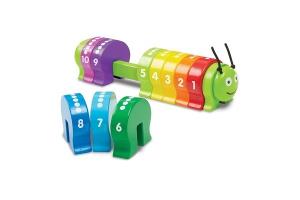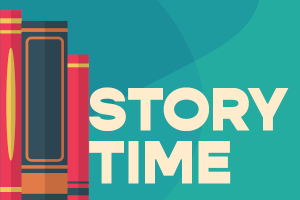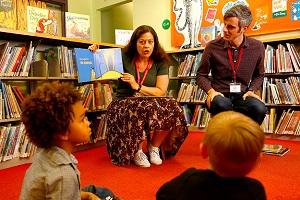Every Child Ready to Read at Your Library

There are five early literacy practices parents and caregivers can use to engage with small children: talking, singing, reading, writing, and playing. Use the menu below to learn more about how each helps your child grow.
- Talking
Talk – children need to receive and create language to learn it
- Have two-way conversations with your children – children learn language by listening
- Respond to what they say and add words to stretch their vocabulary
- Talk while you prepare meals, do chores, get ready for bed, and while in the car
- Speak slowly to young children and enunciate – this helps their brains identify sounds
- Repeat words to strengthen the brain pathways used for language
- Speak face-to-face when talking to infants – they can match shapes to sounds
- Don’t talk baby talk – the more complex the sentences a child hears, the more complex sentences they’ll be able to speak
- Singing
Sing – singing is a great way to learn about language; when we sing, the sounds that make up words become more evident
- Sing the alphabet and nursery rhymes, listen to recorded music, or clap along to a song to demonstrate syllables
- If your child’s ability to verbalize or hear makes singing difficult, engage them in other rhythm-building activities like hand clapping, marching, and body swaying to music
- Reading
Read – share books together
- Reading together increases vocabulary and is the most important way to help children get ready to read. It increases vocabulary and general knowledge. Children who enjoy being read to are more likely to enjoy reading themselves.
- Read every day.
- Make reading interactive. Look at the cover and try to guess what the book is about before you begin. Ask the child questions as you read and listen to the answers.
- Use books to teach new words; as you read, talk about what these words mean.
- Use toys and real objects if you can to illustrate the book. Using real objects to reinforce key ideas while reading benefits all children, particularly children with developmental disabilities.
- Try audiobooks! Check out one of our books on CD or explore our digital collection of audiobooks in OverDrive.
- Writing
Write – scribble, draw, and make tactile art
- Encourage scribbling by providing many opportunities to write and draw. Keep crayons and paper on a table where children can return again and again.
- Get magnetic letters for the refrigerator or make letters from cardboard for children to play with.
- Have them sign their drawings to develop hand-eye coordination and build up their writing muscles. Children also begin to understand that writing represents words.
- Talk about what they draw. Have them make up stories or write captions for their drawings so they make the connection between written and spoken language.
- Playing
Play – children experience the world through play while developing fine and gross motor skills, cognitive concepts, language, and social skills
- Play helps children think symbolically so give them plenty of unstructured playtimes.
- Encourage dramatic play with puppets, dolls, or stuffed animals. Making up stories this way develops narrative skills so children understand that stories have a beginning, middle, and end.
- Have your child tell you a story based on the pictures in a book.
- Create a safe space for play and encourage your child to explore their environment; some children may need extra support when engaging in independent exploration.
- Provide toys that engage many senses – rattles, textured balls, vibrating toys, and colorful blocks.
Baby and Preschool Programs
Baby Time - offers simple rhymes, movements, and songs that you can share with your babies. Take a few minutes to enjoy this short program which offers some bonding time with your little one.
Story Time - geared towards different age groups, such as babies, toddlers, preschoolers or school-age children. Usually consists of an opening song, several age-appropriate books read aloud, interspersed with fun activities such as fingerplays or flannel board stories, and ends with a closing song.
Music and Movement - consists of simple songs, rhymes and fingerplays to keep children ages 3 to 8 moving and dancing. May include shakey eggs and musical instruments. Although this program focuses on moving and dancing, action and musical books are also a great addition and may be included.
1,000 Books Before Kindergarten
The concept is simple, the rewards are priceless. This program encourages you to read books – any books – to your newborn, infant, and/or toddler. The goal is to have read 1,000 books before your little one starts kindergarten. Reading together helps develop important pre-reading skills that provide a solid reading foundation – a key to school and learning success. Plus, sharing stories together is fun! Go to our site and select “Register an Individual or Family” to get started.


